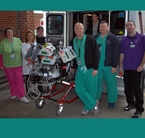
The ECMO transport team, from left to right: Transport Coordinator Liz Berg, Transport Director Jamie Schwartz, emergency vehicle operator Nick Hannigan, ECMO Coordinator Gary Oldenburg, pediatric transport nurse Philomena Costabile, ECMO specialist/RT Chip Custis, and paramedic Eric Henderson.
Hopkins Children’s already had the heart-lung bypass system known as ECMO (extracorporeal membrane oxygenation) when it began to develop a ventricular assist device (VAD) program two years ago. That meant children awaiting heart transplant at Hopkins could be weaned off ECMO to a VAD, which takes over the pumping function of the heart, as a longer and more stable bridge to transplant. Typically patients can remain on ECMO for only up to four weeks because of associated bleeding and infection risks, while patients may remain on a VAD for months awaiting a donor heart.
That was great news for Hopkins Children’s patients, but what about those heart failure patients already on ECMO at other hospitals that did not have VAD or pediatric heart transplant programs? How could they get to Hopkins Children’s without being taken off the life-saving ECMO pump?
“In putting together the ventricular assist device program it became apparent to us that we were the only pediatric heart transplant and VAD program in the area, which raised a question: ‘How could we handle patients at other hospitals already on ECMO?’” says respiratory therapist and ECMO coordinator Gary Oldenburg. “It was kind of an aha moment.”
The aha answer was ECMO transport, a model used by only a few other pediatric transport teams around the country. Oldenburg and critical care and transport specialist Jamie Schwartz set the wheels in motion and with their multidisciplinary team began designing ways to convert an existing ground ambulance into a ground ambulance with ECMO. That would be no easy chore when you consider a hospital ECMO machine is about the size of an office desk. Also, the system would have to be extremely stable to reduce the patients’ high risk of bleeding.
“Because patients on ECMO have to be anticoagulated, the bleeding risks are really significant,” says Schwartz. “The patient’s entire cardiac output is running through tubes, so disrupting them could mean a bloody mess, and even jiggling the tubes a little bit could cause bleeding.”
“We had to involve other areas like the blood bank and clinical engineering in addition to the ECMO team, nursing and respiratory therapy,” says Oldenburg, “and the more we dove into it the more complex it got.”
The solution was a portable ECMO pump about the size of a desktop computer connected to a customized shelf fastened overhead to an ambulance stretcher. The patient stretcher and portable ECMO pump became one unit that could smoothly slide in and out of the ambulance and pediatric intensive care units. But would it work?
Staff training and a simulated dry run with a mannequin led to some troubleshooting and fine tuning, which turned out to be serendipitous when the team got their first call two weeks later. An infant was in heart failure at a Northern Virginia hospital that did not have a VAD or pediatric heart transplant program. The staff there was about to call a mobile ECMO program in Pittsburgh when it learned about VAD and ECMO transport at Hopkins Children’s, which was much closer to the patient's home. The team of one critical care physician, a pediatric transport nurse, two ECMO specialists (respiratory therapists trained in ECMO care), one critical care paramedic and a critical care emergency vehicle operator, successfully transported the patient back to Hopkins Children’s. Two months later after being transitioned to a VAD, the patient received a new donor heart.
“We gave the patient the opportunity to have a heart transplant, which was not offered at the other hospital, and to be close to home,” says Schwartz.
“I’m so glad we did the initial simulation, which showed us that teamwork is a crucial piece in the actual transport,” says Oldenburg. “We pre-planned so well that the transition from their ECMO to our equipment was seamless. It went very well.”
Where does ECMO transport at Hopkins Children’s go from here? For now the team is transporting ECMO patients within 200 miles or four hours from Hopkins Children’s. But ECMO transport by air is on the horizon, Oldenburg says, after team members have some successful ground runs under their belt.
“As people realize we have both VAD and pediatric heart transplant programs with ECMO transport,” Oldenburg says, “they’ll consider us over those centers that are farther away.”
For consultation with a pediatric intensive care specialist or to request critical care transport, call: 410-955-5260 or 1-800-999-7428 (PICU) for out-of-state calls.
